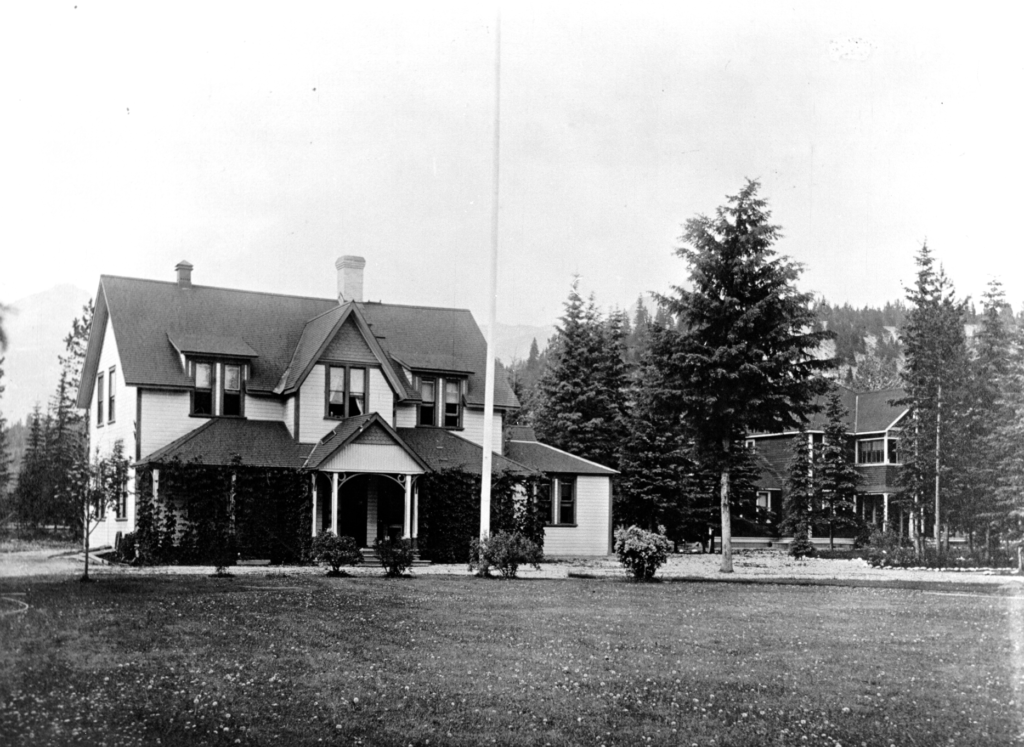Golden BC Hospital History
From the Hospital Supplement of the Golden Gazette

History of Hospital Care in Golden During the Last Century
David Thompson of the N.W. Company was the first white man to travel through the Columbia Valley after crossing the Rockies over Hose Pass.
No doubt he carried simple remedies, and when his wife accompanied him she would act as nurse as occasion demanded.
James Hector of the Palliser Expedition followed the same route in 1849, but no settlement was made in the area until the coming of Walter Moberly with his survey party in 1871.
Doctors and hospitals were hundreds of miles away; fortunately, these hardy men were seldom sick. By 1881, Major Rogers and other C.P.R. surveyors camped below the Golden hill at “The Cache.”
A solid log cabin was built to guard their supplies from the raids of the bears which were so numerous, and by 1883, the construction of the “Big Hill” at Field brought large numbers of laborers into the construction camp which was near the Yoho Camp grounds.
A hospital tent was an essential part of each camp, with a doctor brought in by hand car from Banff to tend the injured and sick. The site of this camp and hospital is marked by a plaque on what remains of a large outdoor oven, which had a capacity of 100 loaves a day.
As the laying of the steel progressed, camps were built at both Golden and Donald. Hospital Creek took its name from the location of the camp and tent at the mouth of the canyon. (One mile north of Golden).
Here, in addition to ordinary casualties, the victims of an outbreak of small pox were treated and some of the dead were buried nearby.
With completion of the railway, the camps were abandoned, but now settlers began to move into the valley.
The C.P.R. used its influence to persuade the B.C. Government to offer a grant of $2,000 for the building of a general hospital in the district. A further $1,000 was required to be raised by the residents.
The C.P.R. had expected to use this money for the reconstruction of the tumbledown hospital in Donald.
However, there was some dispute between the C.P.R. and its employees over the control of the operation of the proposed hospital and meantime Captain Armstrong, of riverboat fame, travelled to Victoria and guaranteed the necessary $1,000 from Golden.
The residents quickly raised the sum of $1,500. And construction began under the direction of a Board, consisting of C.A. Warren, W.C. Wells, W.G. Nielson and Connacher, the last named dying in the new hospital shortly after completion in 1893.
During construction, a frame building, later to become the isolation hospital, was used for the increasing number of patients.
Dr. Brett of Banff was called in for emergencies.
It was not long before the building was used to its capacity of nine patients, and in 1906 a verandah was built on the front and was often used in the busy summer months for extra beds. The building contained two wards downstairs and one upstairs, a surgery, bathroom, kitchen, nurses’ quarters and dining-room, while wide hallways held cupboards for supplies and laundry.
The land, a Crown grant provided large and beautiful grounds, with well-kept lawns and flowering shrubs and trees. Flower beds were aglow with peonies, lilies, dahlias and gladioli and sweet peas.
Here many enjoyable garden parties were held in aid of the hospital. There was an ice house, morgue and sheds of many descriptions. A cabin for the janitor stood near the channel of the Kicking Horse River. A tall flagpole stood in front of the building and this was moved to the Civic Centre in 1958 for the raising of the Centennial Flag.
In 1908, a second building was erected for maternity patients and a maternity nurse now replaced the two-mid-wives who had aided the pioneer women of Golden; Mrs. J.W. Connor and Mrs. Woodley.
A covered walk connected the two buildings for the convenience and comfort of the staff.
One janitor, George Murray kept cows and cultivated a vegetable garden whole a Chinese cook Sam, looked after chickens, so that patients were well supplied with fresh produce.
Dr. Ewart, who joined Dr. Taylor, in 1913, often worked in the flower gardens in his spare time.
Dr. Taylor, after twenty-two years of faithful service, joined the Medical Corps in 1915 and after the war remained with the Department of National Defense. He was stationed in Victoria until his death some years later.
Dr. Ewart also went overseas in 1917, and a Dr. Jones came occasionally from Revelstoke in his absence. On demobilization, Dr. Ewart returned to Golden where he remained a much-loved physician until his sudden death in 1940.
In 1917 the maternity hospital was altered to its present form by the addition of a large general ward with two rooms above, and in 1918 the old “General” was dismantled and the salvaged lumber shipped to Alberta for the prairie homestead of Roy Lindsay.
The remaining building was town down in 1960.
After the closing of the Columbia River Lumber mill in 1926, a long struggle to maintain the hospital began.
During the depression years, Dr. Ewart served for the meagre salary of $35 a month, and many hospital and doctor bills were paid in supplies of firewood or farm products, but the high ideals of service remained.
